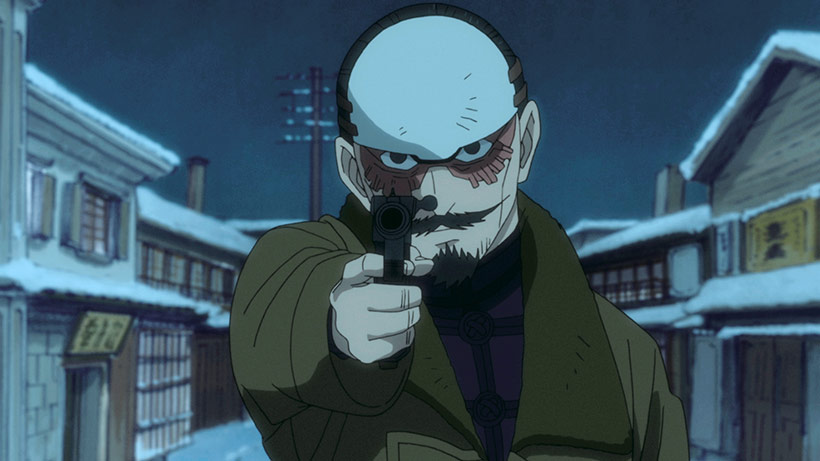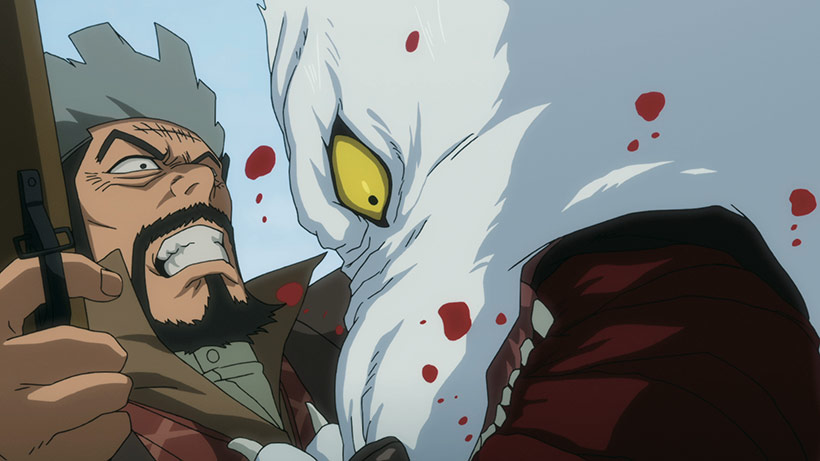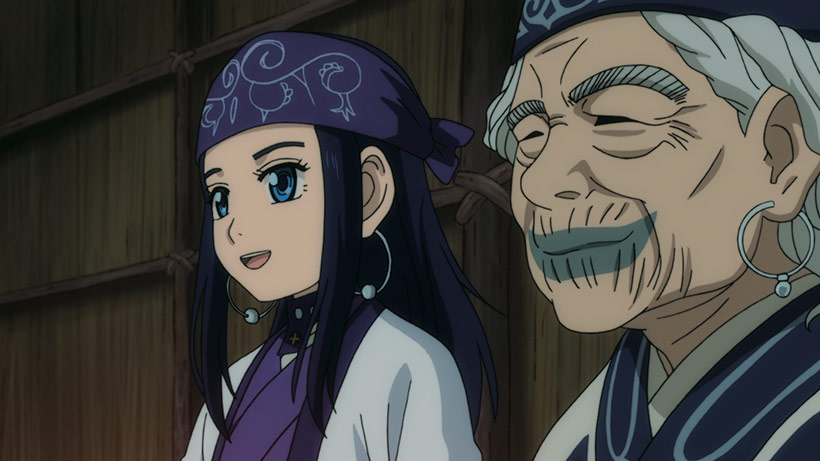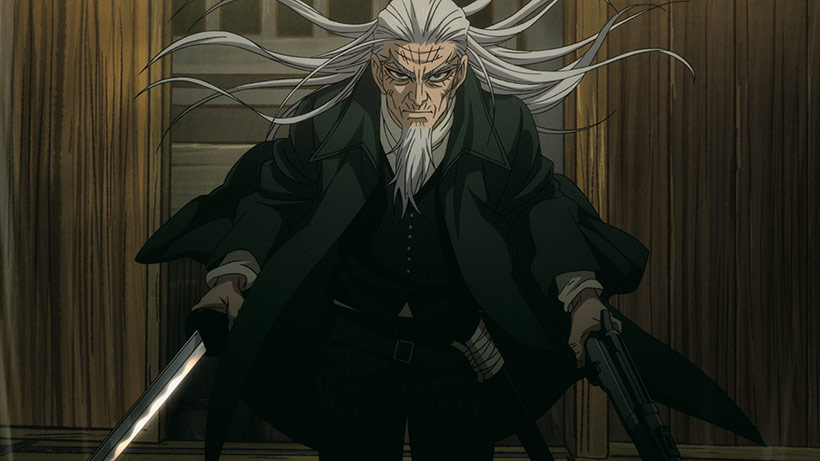Golden Kamuy Complete Season 1 travels an interesting road by pairing a drifting ex-serviceman panning for gold in Hokkaido with an Ainu girl in search for a secret and legendary haul of the same. The duo find their fates intertwined as they begin their search in the countryside and nearby cities in the hope of securing the means to achieve their goals.
Golden Kamuy Complete Season 1 hits hard and fast establishing its narrative. Saichi “Immortal” Sugimoto finds himself panning for gold in the northern regions of Hokkaido. His partner, while drunk, tells him of the legend of a mysterious inmate from the Ashabiri prison. This prisoner secured an enormous fortune in gold stolen from the Ainu in cold blood and created the map to its location via the tattoos he gave to his fellow inmates.
While Sugimoto initially dismisses it, when his travelling companion recovers from his stupor and tries to kill him for having said too much his interest is piqued, especially when he finds an unusual series of tattoos on the man’s skin after a ferocious bear attacks and kills him. “Immortal” Sugimoto escapes from the bear’s attack thanks to the help of an Ainu girl, Asirpa, and her guardian wolf. Asirpa and Sugimoto share their stories, with Sugimoto explaining how the death of his friend on the battlefields prompted his journey. Asirpa in turn explains that her father was amongst the group of Ainu killed by the same inmate.

Their shared purpose comes together for arguably selfless reasons. Asirpa wants to use the gold to help the Ainu people gain independence in the aftermath of Japan’s rapid industrialisation and the country’s policy of forced assimilation. Sugimoto hopes the gold he can find will help pay for his friend’s widowed wife to receive medical treatment for her failing eyesight and ensure his family can live a comfortable life in the wake of his death.
In Golden Kamuy Complete Season 1 we see what feels like the beginning of a long serial, with the arcs in this collection working to establish the change sweeping Hokkaido in the aftermath of the Russo-Japanese War and the players dominating the scene in what seems like a power vacuum. Similar to Sugimoto, other military factions have found themselves in Hokkaido and are vying for power, as are other groups of gangsters and revolutionary underground movements still reeling from the Meiji Restoration more than 30 years prior.
The common thread amongst these competing players in Golden Kamuy Complete Season 1 is they all seek wealth to pursue their goals – the military groups need money to buy weapons, the gangsters want to leverage wealth to create a base of power and the revolutionary forces seek the gold to fund a civil war against the new regime. These big picture elements clash strongly with Asirpa’s goal to guarantee the freedom and independence of the Ainu people to maintain their culture and Sugimoto’s promise to provide for his dead friend’s family.

In the broader sense we see how Golden Kamuy Complete Season 1 is all about these larger than life conflicts, and in a sense it is – there’s plenty of fantastic set pieces, betrayals, power plays and cliffhanger moments between episodes to drive this goal. Extending this, the production values are for the most part really solid with some very impressive detail (except for the CG bears – they don’t quite fit the show’s aesthetics). The story burns along at a solid pace, though the ending seems incredibly abrupt for this collection.
But the core guts of the show, and why it elevates itself, is how it’s ultimately about redemption and transformation. For Sugimoto, his sheer physicality and seeming immortality that manifests itself through his unerring recovery from physical injuries belies someone inherently restless looking for meaning. He doesn’t find it in his childhood and fails to find meaning amongst the bloody combat on the battlefields of modern warfare. It’s in the stillness of the Hokkaido forests and in the culture and religion of the Ainu that he begins to find a deep and powerful meaning to life. While the anime frequently leans on the other fantastical action sides of its delivery, the sticking point here is Sugimoto’s journey and watching him begin to realise he’s on the cusp of a journey to discover his purpose.
We see something similar with Asirpa. In one sense she acts as Sugimoto’s guide away from the profane world he lives in to be absorbed to something closer to the raw power of nature. But what makes her character fascinating is how she struggles reconciling her cultural role as a traditional Ainu woman and combining this with a modern interpretation of classical femininity by infusing it with a sense of independent, strong self-assuredness. Much of the dialogue in the Ainu village focuses on how Asirpa is defined by her more masculine traits as an accomplished hunter and master of her physical surroundings. There are moments where she pays incredibly sincere tribute to her traditional culture, but we see how this clashes to empower her yearning for a more modern sense of female empowerment as well as modernising the Ainu culture in a way that gives options for future generations to evolve their culture in ways they wish while maintaining independence and core values.

This exploration of Ainu culture in Golden Kamuy Complete Season 1 really makes this a unique anime. My academic knowledge on how Ainu culture and their history is treated in Japan at the time of writing this review is limited, though I was first exposed to it years ago as an undergrad student. I found the troubled history between mainstream Japanese society and the country’s indigenous groups to be a genuine surprise given how infrequently Ainu people are acknowledged in the books and popular culture I’d consumed by that point. This review and my level of existing knowledge of Ainu culture and their history of forced assimilation in Japan, particularly following the push for modernisation as a result of the Meiji Restoration, means I can’t do the issue justice in this write-up.
However, I would very much encourage you to read some great pieces on how Golden Kamuy approaches the Ainu language, culture and political challenges often posited throughout the anime (and by extension the original manga). Sakura T over at The International has written a short piece reflecting on her experience reading the Golden Kamuy manga, and ChariotWheel has posted a great entry on reddit discussing some of the broader impacts of indigenous cultures around the world before drawing the discussing to the Ainu people and how this is represented in Golden Kamuy.
Robin Segundo has posted on her blog how Golden Kamuy proved an accessible form of inspiration for her studies owing to the high level of detail on the clothing and broader representation of the Ainu people in Noda Satoru’s original manga. While Golden Kamuy is only referenced briefly, Jude Isabella’s article on the ongoing struggles of the Ainu for recognition makes for fascinating reading.
Moving over to the Blu-Ray release of Golden Kamuy Complete Season 1, this is a fantastic package. Aside from a solid transfer and HD audio in both languages, it also features textless ops/eds, select commentaries, Japanese commercials and 12 little animated shorts that are tremendously good fun. The content in itself holds up incredibly well, but the plethora of bonus features are a great addition to this one.

Golden Kamuy Complete Season 1 is ultimately a fascinating and engaging journey. There’s a delightful number of layers to appreciate in this anime – as a series of action and adventure set pieces it holds it own with great choreography and some unapologetic gore. As a piece of historical fiction there’s plenty to digest with just the right amount of hyperbole. For those prone to enjoying some deep and meaningful moments, Sugimoto’s and Asirpa’s journey provides a lot to reflect on. Finally, unique to this series is the attention to detail given to the Ainu people and their culture which is a joy to engage with. While these elements may not bring everyone across, it’s hard not to recommend it – my only concern now is how they follow this up in the next season.
A review copy was provided by Madman Entertainment to the author for the purpose of this review.





